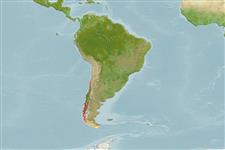Common names from other countries
Environment: milieu / climate zone / depth range / distribution range
Ecologia
; intervalo de profundidade 20 - 278 m (Ref. 87801). Subtropical
Southeast Pacific: Probably endemic to Chile.
Length at first maturity / Tamanho / Peso / Idade
Maturity: Lm ? range ? - ? cm
This species is found in exposed areas with rocky substrate at depths of 20 to 278 m. Occasionally it is found on biogenic substrates (Ref. 87801). Solitary (Ref. 2377).
Life cycle and mating behavior
Maturidade | Reprodução | Desova | Ovos | Fecundidade | Larvas
This species has separate sexes (Ref. 87801).
Häussermann, V. and G. Försterra. 2009. (Ref. 87801)
Status na Lista Vermelha da IUCN (Ref. 130435)
Status no CITES (Ref. 108899)
Not Evaluated
Not Evaluated
Perigo para os humanos
Harmless
Uso pelos humanos
| FishSource |
Ferramentas
Mais informação
Idade/Tamanho
Crescimento
Comprimento-peso
Comprimento-comprimento
Morfologia
Larvas
Abundância
Fontes da internet
Estimates based on models
